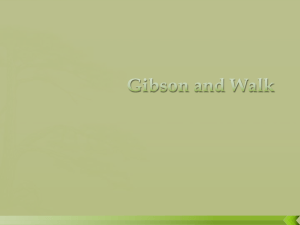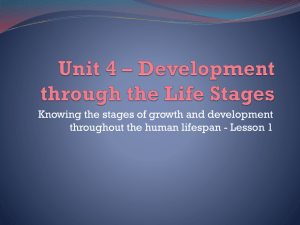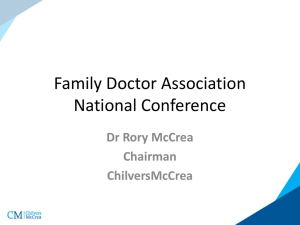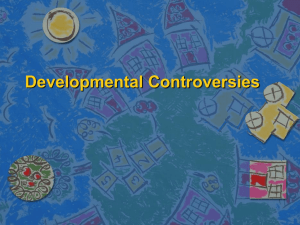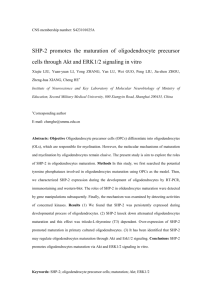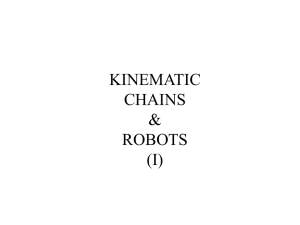Postnatal Development of Behavior
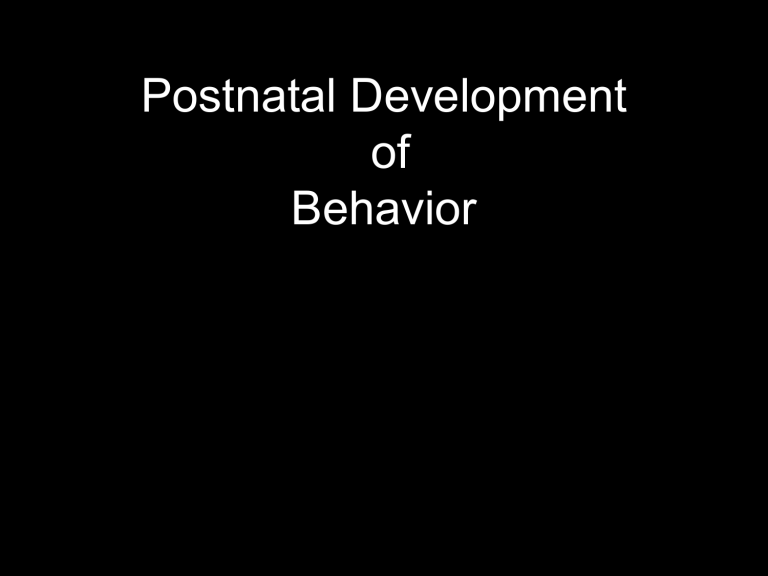
Postnatal Development of
Behavior
Unique Problems Faced by Altricial Neonates
1. Sensory immaturity stimuli available to adults not available to neonate
2. Motor immaturity ability to act on motivations is limited
3. Physiological immaturity motivational systems, regulatory systems
4. Morphological immaturity small size
Difficulties in Assessing
Behavioral Development
Identification of eliciting stimuli
Motivations different from those of adults
Response definition
(recall “isolation distress” of infant rats)
Mechanisms of
Behavioral Maturation
CNS maturation
Threshold changes
Integration and individuation
Response competition
Morphological change
Permissive/supportive environment
Permissive
Environment
CNS maturation (also in development of locomotion in the frog)
How do we know if hiccuping and breathing are the same behavior that differ only quantitatively, or whether they are qualitatively different behaviors? Should function matter?
Should neural substrates matter? (Recall suckling and feeding, non-shivering thermgenesis; Response Definition)
First few weeks
Four months to one year
After approximately one year
McGraw, M. (1939) Swimming behavior of the human infant.
J. Pediatrics, 15, 485-490.
Is swimming at one year the same behavior as it is in the first few weeks?
Mechanisms of
Behavioral Maturation
CNS maturation
Threshold changes
Integration and individuation
Response competition
Morphological change
Permissive/supportive environment
First few weeks
Four months to one year
After approximately one year
McGraw, M. (1939) Swimming behavior of the human infant.
J. Pediatrics, 15, 485-490.
Encephalization and the maturation of behavior
British neurologist John Hughlings Jackson
“Doctrine of dissolution”
a. Nissl stain
(cell bodies)
Prosencephalon
Histology
Thalamus
Mesencephalon
Rhombencephalon
Hypothalamus
Subthalamic nucleus
FIG. 1. Parasagittal section through the brain of kitten K-l, showing the level and extent of transection. The rostra1 tilt of the cut is the result of growth of the brain in that direction in the weeks after the transection. Weil stain.
b. Weil stain
(myelin)
Histology
Kitten #1
Kitten #3
Kitten #2
Behavior of Decerebrate Kittens
Suckling abolished
Decerebrate rigidity not observed
Reflexive eating and lapping of milk emerged at normal age of weaning
Temperature regulation was only slightly impaired
All of the following developed in normal chronological order auditory reflexes (orienting, pawing at source of sound) tactile placing reactions defensive reactions (piloerecton, hissing, bared teeth, biting) grooming postural reflexes
Sleep-wake states developed normally
Visual recognition and social behavior were absent
Some behaviors, e.g. pounce, “kill” behaviors, developed precociously, were exaggerated in form (hypermetria) and directed toward inappropriate stimuli
There were bouts of uncontrolled locomotion (hyperkinesis), with kittens sometimes running pell-mell off table-tops
Also, “compulsive” climbing was observed.
First few weeks
Four months to one year
After approximately one year
McGraw, M. (1939) Swimming behavior of the human infant.
J. Pediatrics, 15, 485-490.
Zelazo, P.R.,
Zelazo, N.A. &
Kolb, S. (1972)
“Walking in the newborn infant.
Science, 176,
314-315.
The first supporting evidence is the likelihood that newborn stepping does not
‘ disappear ” , but that stepping in the upright posture is masked by other developmental changes in the infant. First, in infants who no longer step, a simple alteration of posture -- that of placing infants supine — releases pattern generation identical to that of steps. Thelen and Fisher have suggested that biomechanical factors, rather than changes in centralneurological organization, account for this paradoxical result. Specifically, they suggested that the rapid acquisition of s.c. fat in the first 2 or 3 months of life taxed the available muscle strength when infants were in the demanding upright posture. When infants were placed supine, movements were facilitated. Indeed, infants who gained weight most rapidly between 2 and 6 weeks showed the most rapid decline in step rate. When growth changes were simulated by adding small weights to the legs of 1-month-old infants, their step rate and amplitude declined. Likewise, placing infants in torso-high water restored high levels of stepping, even in 3-month-old infants. These results suggest that when the context was appropriate, the underlying coordination traditionally believed to be cortically inhibited would become manifest.
Thelen, E. & Bradley, N. (1988) Motor development: Posture and locomotion.
In E. Meisami and P. S. Timiras (Eds.) Handbook of human growth and developmental biology. Volume I: Part B. CRC Press, Boca Raton, FL.
Rat Somatosensory Cortex
From Wise, Fleshman & Jones (1979) Neuroscience, 4, 1275-1297
Increased opportunities for spatial and temporal summation.
Stehouwer, D.J., McCrea, A.E. & Van Hartesveldt, C. (1994)
L
-DOPA-induced air-stepping in preweanling rats: II. Kinematic analyses. Dev. Brain Res., 82, 143-151.
Stehouwer, D.J., McCrea, A.E. & Van Hartesveldt, C. (1994)
L
-DOPA-induced air-stepping in preweanling rats: II. Kinematic analyses. Dev. Brain Res., 82, 143-151.
Stehouwer, D.J., McCrea, A.E. & Van Hartesveldt, C. (1994)
L
-DOPA-induced air-stepping in preweanling rats: II. Kinematic analyses. Dev. Brain Res., 82, 143-151.
Stehouwer, D.J., McCrea, A.E. & Van Hartesveldt, C. (1994)
L
-DOPA-induced air-stepping in preweanling rats: II. Kinematic analyses. Dev. Brain Res., 82, 143-151.
Stehouwer, D.J., McCrea, A.E. & Van Hartesveldt, C. (1994)
L
-DOPA-induced air-stepping in preweanling rats: II. Kinematic analyses. Dev. Brain Res., 82, 143-151.
Stehouwer, D.J., McCrea, A.E. & Van Hartesveldt, C. (1994)
L
-DOPA-induced air-stepping in preweanling rats: II. Kinematic analyses. Dev. Brain Res., 82, 143-151.
Soiled nest shavings
Start Box
Clean nest shavings
Soiled nest shavings
Clean nest shavings
Mechanisms of
Behavioral Maturation
CNS maturation requisite circuitry not yet active
Activation of existing circuitry circuitry present, not active under normal circumstances
Integration and individuation complex behaviors emerge when all component parts become functional, differentiation of gross behaviors
Response competition behavioral dominance changes with age
Mechanisms of
Behavioral Maturation
Physiological Maturation physiological development allows for new solutions to problems
Morphological change behaviors physically not possible
Permissive/supportive environment special conditions necessary to allow for behavioral expression
New attractor states
Changing value of control parameters in dynamical systems


